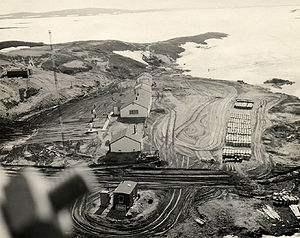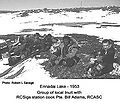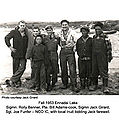Ennadai Lake NWT and Y station
| Ennadai Lake NWT and Y Station | |
|---|---|
| Nunavut | |
 | |
| Coordinates | |
| In use | 1949 - 1954 |
Opened in the Summer of 1949 to provide weather information. Handed over to the Department of Transport on 18 September 1954.
A Brief History of the Ennadai Lake Signals Station
The Government of Canada's Meteorological Division in 1949, as in most other years, was pleading with Department of Defence for the installation of more weather reporting radio stations in the vast unpopulated areas of the Barren Lands of the NWT with the result that a decision was made to install a RC Signals station at Ennadai Lake, 250 miles northwest of Churchill. Much has been said about the remoteness of the Sigs stations at Baker Lake and Fort Reliance but they could well be referred to as metropolis by comparison with Ennadai Lake. Whereas Baker Lake had a Hudson Bay Company store and a RCM Police detachment and Fort Reliance had a two man RCM Police detachment and a few itinerant white trappers, Ennadai had nothing, absolutely nothing, except a small nomadic band of Eskimo which was to become a veritable millstone around Signals neck in the ensuing years.
A Signals party consisting of WO 2 Bill Joyce and Sig. Wayne Fries, technicians, Cpl. Joe McIsaac, to be NCO IC station; Sigs Townley and Cotton, operators and Pte Pitre, cook left Edmonton for Ennadai Lake 9th July 1949. They travelled RCAF North Star to Winnipeg, weekly 'Muskeg Special' train Winnipeg to Churchill and completed the journey Churchill to Ennadai Lake by RCAF Canso on the 15th July. An RCE construction crew was also flown in and all construction materials, supplies and radio equipment were airlifted to the site at the rate of at least one Canso flight per day from Churchill.
Tent accommodations were set up and construction was commenced immediately. Using a battery operated C52 set, communications were established with Edmonton and Churchill for close liaison during the construction period. Despite heavy rains, hordes of black flies and mosquitoes and shortage of tobacco, construction and installation work was successfully completed by early October. Buildings constructed were as follows: Combined station and quarters 68'x 24'; engine house 20'x 20'; warehouse 20'x20'; and ice house 20'x20'. The technical installations were comprised of a PV. 500 low frequency, and a TE 176 high frequency transmitters, necessary receivers, two Lister Diesel power plants, two 150 foot towers for LF transmitting antennae and three 48 foot towers for SW transmitting and receiving antennae. The staff was now in a position to assume the duties for which the station had been established, namely weather reporting. Regular schedules were established with McMurray and a full daily complement of weather sequences started to flow to the 'outside' on the 8th of October 1949.
During the period 1949 54 when RC Signals personnel manned the Ennadai Lake Radio Station they were called upon many times to render medical assistance to the Kazan River Group of Eskimos which numbered about 45 and were scattered over a wide area within a radius of approximately 60 miles from the Ennadai Lake Radio Station. On more than one occasion they have been credited with saving this Eskimo band from starvation. These Eskimos were a primitive tribe and depended entirely on the meat of the caribou for sustenance for themselves and their dogs, and the skin of the caribou for their clothing. When the annual caribou migration by passed this area, which is 150 miles northwest of Fort Churchill, in the winter of 1949-50, the Kazan Group was faced with an extremely critical situation and only the prompt and commendable actions of Cp1 Joe McIsaac and other RC Signals personnel stationed at Ennadai Lake saved the band from extinction by starvation. When he became aware of the situation in April 1950, McIsaac contacted the RCM Police in Churchill, advised them of the Eskimos predicament and arranged for the evacuation of the band by air to Neultin Lake, 100 miles southeast of Ennadai, where caribou and fish were plentiful. McIsaac rounded up the scattered Eskimos, concentrated them at Ennadai Lake Radio Station and fed them emergency rations until aircraft arrived and carried out their evacuation to Neultin Lake.
During the rounding up process and on checking the families as they arrived at Ennadai, it was noticed that one notorious old Eskimo character named Pongalak was minus his step son. When questioned he said the boy, being weak from hunger, had lagged behind on the trail but would arrive shortly. Suspicious of this story, McIsaac dispatched a party to back track on the trail and the boy was found miles from camp, semi conscious and unable to walk. He was brought to the Radio Station and medical advice was obtained by radio from McMurray. He was fed the prescribed formula of water, salt and sugar, followed shortly by tea and soup. Within two days he had made a marvelous recovery and was placed on a solid diet. Subsequent investigation proved that Pongalak had systematically starved the step son ever since first feeling the pinch of privation and had left him on the trail to die, reasoning that he was an unnecessary burden which would only hinder his own chances of getting to Ennadai and catching the plane for Neultin Lake. Undoubtedly the boy owes his life to the prompt action and care of Signals personnel.
By the following Spring of 1951 the whole band had migrated back to the Ennadai Lake area and Sigs were again faced with the same old problem. However arrangements have since been made with the proper authorities to improve the living standards of this Eskimo group by supplying them with rifles, ammunition and traps with which to hunt and trap. Provision has also been made to bale their furs at Ennadai and ship them to the RCM Police in Churchill, who in turn sell the furs, convert the proceeds into food, ammunition etc which is flown back to Ennadai for distribution to the Kazan group.
Again in May 1954, Sgt. Fred Waite, IC Ennadai Lake at that time, saved this tribe from being wiped out by influenza. When the epidemic was discovered Waite advised Churchill by radio and requested that a doctor be flown in. However weather conditions prevented such a flight and Waite was forced to assume the role of medico. Acting on radioed instructions from a qualified doctor in Churchill and using the station's supply of penicillin and aspirin he ministered to 22 stricken Eskimos, safely pulling them all through. During this time he developed flu symptoms himself but managed to carry on. Sgt. Waite's efforts in this case won him a citation from the Chief of the General Staff which said "His prompt action and sound judgment were in accordance with the best principles of medical practice'.
Medical aid was rendered to these Eskimos by Sigs personnel on many other occasions in cases ranging from plain lead swinging and simple belly ache to blood poisoning and influenza as mentioned above. The mere fact that the band still exists is a monument to the goodwill, perseverance and versatility of Signals personnel.
RC Sigs left Ennadai in 1954 when, with no noticeable weeping or gnashing of teeth, the Signals Territorial Eskimo Medical Clinic otherwise known as RC Signals Radio Station, Ennadai Lake, was turned over to the Department of Transport on the September 18th. All equipment on the station, except stores of an exclusive military nature, were handed over.
The operation, maintenance and administration of this station had been extremely difficult during its five year existence due mainly to its remoteness. Those difficulties were further complicated by the almost continuous necessity of rendering aid to the Kazan River group of Eskimos living in the area, to save them from extinction by sickness and starvation.
The loss of Ennadai Lake left the System with 20 stations in operation.
Addendum:
In a note accompanying his photos of Ennadai station Jack Girard sent in the following information:
"Much of the heavy construction material and other supplies to be used in the establishment of the radio station was transported into Ennadai from Churchill by cat train over the frozen lakes and muskeg. Fortunately for station personnel, one of the tractors broke down and was considered to be beyond repair. This D-6 Caterpillar tractor was abandoned at Ennadai when the cat train returned to Churchill. Some enterprising person (?) managed to repair the tractor and it became a very important asset to the station. It was used to maintain the ice runway dragging rollers behind it; hauling up supplies to the station from the runway, or the dock in summer, on a stone boat; and, various other tasks."
Related Pages
- No related pages at this time
Related Items
| ||||||||




